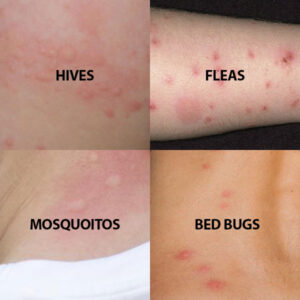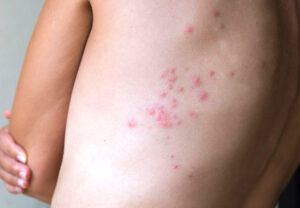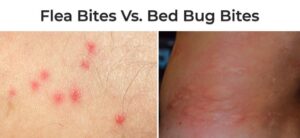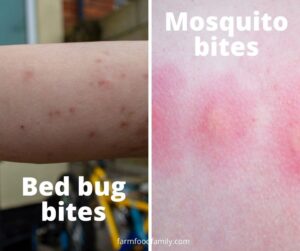Bed bugs are parasites that feed exclusively on human blood, which is their sole source of nutrition. Every step of a bed bug’s existence, from nymph to adult, necessitates the need for a blood meal, which results in red lumps on human skin known as bed bug bites. It is the heat of our bodies and carbon dioxide in our breath that attracts bed bugs, which are nocturnal parasite insects.
During the day, they would conceal themselves in cracks and crevices, emerging only at night to eat. You may come into touch with bedbugs in a variety of settings, including hostels, hotel rooms, passenger aircraft, bus seats, and even libraries.
Even though bedbugs are not known to transmit illness, their bites may be irritating, and some individuals are more sensitive to being bitten by bed bugs than others, leading to the development of an itchy rash that, with persistent scratching, can culminate in a bacterial infection.
Identifying Bed Bug Bites:
It is not always simple to distinguish bed bug bites from other insect bites that you may come across on your body. Bedbug bites appear as little red lumps or swellings on your skin, similar to those caused by the majority of insects.
When bedbug bites, they puncture your skin with their ‘beak,’ excreting a little amount of anaesthetic and injecting an anticoagulant to keep your blood from clotting, allowing them to more readily feed on your bloodstream. The size of the bites and the irritation of the bites are often determined by a person’s sensitivity to the anticoagulant.

A bed bug feed might take anything from 10 minutes to an hour on average. The process of finding a suitable blood artery to feed on, on the other hand, may take many tries. They are very sensitive to movement, and if you walk, they will stop eating until you return and bite again.
During the feeding process, the bed bug gains weight and changes colour as it fills up with blood from the host. Depending on how sensitive you are to being bitten, you may see bed bug bites within a few hours or you may not notice them for a few days.
A small number of individuals may have no response to being bitten, but others may have a severe reaction, with the bites swelling, itching, and even blistering, as well as a burning feeling.
What Do Bed Bugs Look Like?
Let us see what do bed bugs look like. Bed bugs often bite in tight lines or clusters on exposed skin, which is why they are called “bed bugs.” If you have many bites on different parts of your body, you have likely been bitten by more than one-bed bug. Depending on how sensitive a person is to bites, the size and irritation of these little red, raised lumps may vary significantly.

Understanding the typical indicators of bed bugs and knowing where to search are two things that will help you locate evidence of bed bugs in most cases. When symptoms do manifest themselves, the bites are often as follows:
- Each bite has a black blotch in the middle of it that is red and swollen (they may also look like a hive or welt)
- Organised in lines or clusters, with several bites put together
- Do bed bug bites itch? Yes, it is itchy!
- Burning
- Blisters that are filled with fluid
Additionally, bloodstains on the bedding might be caused by scratching the bedbug bites.
Read Here: Paleo Vs Keto Diet: Which One Is Better?
What Do Bed Bug Bites Look Like?
Let us know what do bed bug bites look like. Bedbugs do not always eat at the same time every night. They are capable of going for many weeks without eating. While this may seem to be a positive development, it might make it more difficult to detect the presence of bedbugs in your home.
It may take many weeks before you notice that the bites are part of a wider pattern of behaviour. And that’s an issue because bedbugs can reproduce quite fast. A female may deposit eggs every 3 to 4 days, depending on her size. If the bite locations are scratched, they might get infected.
Among the peculiarities of bedbug bites is the propensity to discover multiple bites lined up in one row, which may manifest themselves as itchy welts when scratched. Specialists in infectious diseases refer to this succession of bites as the “breakfast, lunch, and dinner” sign to denote the sequential feeding that takes place from one location to the next, as described above.

It may take many days for the bites to manifest themselves in some individuals. The signs and symptoms of a bite may not become evident for up to 14 days after the bite has happened. Because the indicators of bedbug bites are difficult to differentiate from the signs of other bites or skin problems, bedbug bites may go unrecognised or be misdiagnosed as flea or mosquito bites or other forms of rash or skin conditions.
Bed bugs also have glands, and the secretions of these glands may produce musty scents. They can also leave black faecal streaks on bed sheets and in the vicinity of locations where they hide (in crevices or protected areas around the bed or anywhere in the room).
Do Bed Bug Bites Every Night?
A bedbug infestation is possible if you wake up with itching regions on your body that weren’t there when you went to sleep the previous night. This is especially true if you purchased a used bed or other old furniture around the time the bites began. Other indications that you have bedbugs are as follows:
- Having blood stains on your linens or pillows is a nightmare
- Areas of bedbug faeces that are dark or reddish in colour on sheets and mattresses, bed linens, and walls
- Bedbug faeces, eggshells, or shed skins found in hiding places or in regions where bedbugs congregate
- The smell glands of the bugs provide an awful, musty odour.
Immediately remove any bedding from the room if you suspect an infestation and inspect it thoroughly for traces of the bugs or their faeces. Remove the dust cover from the bottom of the box springs and look for cracks or gaps in the wood frame around the box springs. Remove the staples holding the cloth to the wood frame by peeling back the fabric.
Examine all of the areas surrounding the bed, including the inside of books, the edges of carpets, and even electrical outlets to be sure there are no hidden dangers there. Check your closet for different bug bites, which may attach themselves to clothes. You should see an exterminator if you are unsure about the presence of different bug bites.
How To Get Rid Of Bed Bugs?
A bedbug infestation is possible if you wake up with itching regions on your body that weren’t there when you went to sleep the previous night. This is especially true if you purchased a used bed or other old furniture around the time the bites began. But how to get rid of bed bugs?
1. Examine Infested Areas
Because bed bugs reproduce fast, it is critical to locate them as soon as possible when they are discovered. Maintaining this in mind, check the following places for evidence of bedbug infestation:
- Your mattress and box spring’s seams are particularly vulnerable to baby bed bugs.
- Cracks between the frame of your bed and the headboard.
- You may find it between the cushions of your couch as well as between the seams of your cushions.
- Where the carpet meets the wall, along the seam of your carpets, is a good place to start.
- Couches, accent chairs, and futons, for example, have joints where bacteria may grow.
Make use of a flashlight to thoroughly inspect each location. Look for tiny dark or rust-coloured droppings, baby bed bugs, or little light yellow eggs to determine if you have bedbugs. If you discover evidence of bedbugs in any of these areas, you should also inspect your nightstand, dresser drawers, and closet for evidence of bedbugs.
2. Contain The Bugs
Once a bed bug infestation has been found, it is necessary to confine it for preventing it from spreading. One fast and simple method of containing live bed bugs is to suction them up using a vacuum attachment.
To keep live bedbugs at bay, carefully vacuum your mattress, the insides of your drawers, the seams and joints of your furniture, your carpets, and any other areas where you’ve detected evidence of a bed bug infestation, including your closet.
Seal the contents of your vacuum canister in a plastic bag and toss it in the trash after you’re through. Take note that this will not eliminate the bed bug problem; rather, it will simply pick up and transport live bed bugs. Any eggs that have been left behind may hatch and trigger a subsequent infestation.
As soon as you’ve vacuumed all of the affected areas, wash and dry any linens, clothes, or other fabrics that have been exposed in hot water and on a high-heat setting in your dryer. If you are unable to wash and dry an item (such as a sofa cushion), steam may be used to eliminate bed bugs instead.
3. Kill The Bugs To Avoid Further Bed Bug Bites
After everything has been said and done, it’s time to get rid of the bed bugs for good. Use heat or cold to naturally get rid of bed bugs. Increasing the temperature of a mattress or other critical area is an excellent approach to get rid of bed bugs. Consider gathering all of the contaminated bedding or clothes and washing them in very hot water for 30 minutes.
The goods should be dried in the dryer on the highest heat setting for at least 30 minutes after the wash cycle is completed. Put the objects in question in a freezer that is at least 0 degrees Fahrenheit if they are not already frozen. Allow them to remain there for four days to ensure that all bed bugs have died.
How To Treat Bed Bug Bites For Infants?
The following items should be checked for symptoms of bedbugs if you believe your infant or kid has been bitten by bedbugs: the child’s linens, mattress, bed frame, and adjoining baseboards.
Bedbug bites on your newborn or toddler may be treated more effectively by washing the bites with soap and water. Consider using a cold compress, over-the-counter anti-itch creams, or low-strength steroids to provide extra relief. Make certain that the baby’s nails are kept short so that they do not scratch their skin.
To treat the bites, consult with your child’s doctor or pharmacist before using topical steroid creams or administering oral antihistamines to the area. Some drugs may not be suitable for use by infants or young children due to their toxicity.
You may advise them not to scratch their bites if they are at an age when they can grasp your instructions. It may also be beneficial to clip your child’s nails and apply a bandage over the bites to keep them from scratching. Now you know how to treat bed bug bites for infants.
Difference Between Flea Bites & BedBug Bites:
While both flea bites and bedbug bites are generally of the same size and shape, flea bites are distinguished by the presence of tiny dark spots surrounded by a red area, whereas bed bug bites are distinguished by the presence of red lumps that can sometimes blister if you are particularly sensitive to the insects’ bites.

Flies also bite in random clusters, commonly around the ankles, lower legs, and wrists (the most accessible and exposed parts), with itching occurring within a short time after the bite has been received. Bed bugs, on the other hand, tend to bite in linear rows on exposed skin throughout the night.
Until the effects of the anaesthetic utilised by the bed bug wear off, which may take anywhere from a few hours to several days, the bites will remain itchy and inflamed.
Difference Between Mosquito Bites & Bed Bug Bites:

Bed bug bites might be mistaken for mosquito bites in certain cases. There are, however, some distinctions between the two approaches. Mosquito bites are generally sporadic and solitary, appearing on any part of your body without warning. They are instantly apparent and begin to itch as soon as the sting is administered. They normally start out as white, hard elevated lumps that shrink down to a little red bump as time goes on.
Read Here: Wrap It In Style With The Best iPhone 12 Mini Case
How To Treat Bed Bug Bites In Adults?
It is possible to employ natural therapies and “old wives tales” to help lessen the irritation and itching associated with bed bug bites, and there are numerous options available to you.
- Calamine lotion soothes itching and also aids in the drying of rashes and the protection of the skin.
- A paste made of baking soda and water is applied directly to the skin; this method is effective. Allow it to dry completely before wiping it away with a cotton pad.
- The menthol included in dental floss is thought to be an effective anti-itch treatment. To alleviate the burning feeling and itching associated with the bite, apply a liberal quantity on the bite.
- Wicked Witch Hazel herb has a minor anaesthetic action, which helps to relieve the itching produced by insect bites.
- Aloe Vera is effective against bug bites and stings. Several active compounds and amino acids included in Aloe Vera aid to alleviate itching and burning sensations in the skin.
- Lemon juice contains anti-inflammatory and antibacterial characteristics, making it a good choice for cooking. It also has astringent properties of its own. Lemon juice may be used to relieve dry rashes and itching while also lowering redness and swelling on the skin.
Prevention Of Bed Bugs:
The most effective method of avoiding bed bug bites is to prevent the insects from entering, dining on, and reproducing in human habitats. During the day, bed bugs may be found hiding in cracks and crevices in furniture, floors, walls, and mattresses, among other places.
The seams and folds of upholstered furniture may also serve as an excellent hiding spot for little children. Bed bugs have been shown to survive in vacuum canisters and other vacuum-related equipment.
Generally, the insects choose hiding places that are close to human sleeping quarters, such as bedroom walls. The presence of bed bugs in adjacent rooms is typically indicative of a major infestation.
